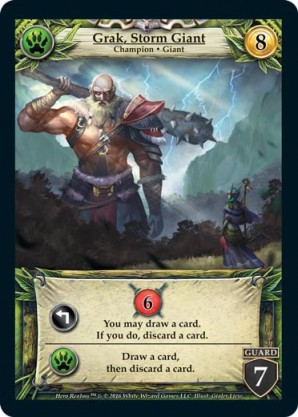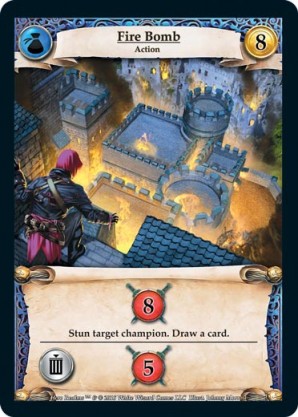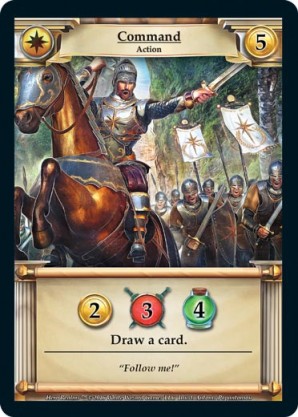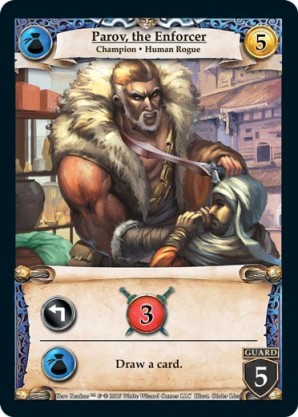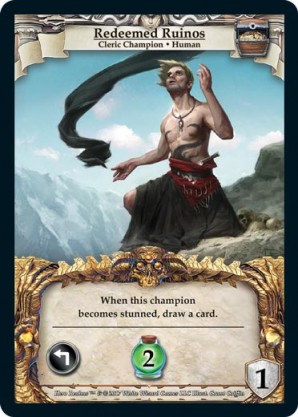Author’s Note: I wrote a similar article for the Star Realms blog several years ago, but wanted to “translate” the article for Hero Realms because many of those same principles apply here. There are, however, some differences (e.g., in Hero Realms you can choose if/when to trigger the draw ally ability whereas in Star Realms you cannot). Additionally, some of the Character abilities in Hero Realms (I’m looking at you Ranger) provide interesting considerations in relation to the “reshuffle” beyond what exists in Star Realms.
The “Reshuffle”: Basic Principles
The “reshuffle” in Hero Realms produces unique strategy considerations, particularly when you will reshuffle mid-turn.
For example, playing a draw card (e.g., Command) or using a Character draw skill/ability (e.g., Channel) when your draw pile is empty will cause your deck to reshuffle during your turn. Any cards in your current hand will not be included in that reshuffled deck. Instead, the cards in your current hand will sit in your discard pile until the next time your deck reshuffles. In other words, when you reshuffle during your turn, the cards in your hand are essentially “lost” for one deck; you will have to wait until your deck reshuffles again to have access to those cards.
This can be good when you are “losing” starter cards for one deck. In other words, for one deck those starter cards aren’t diluting your deck. But this can be a bad thing when “losing” stronger cards. Let me set the stage with three examples.
In each example you can, or will, trigger a reshuffle during your turn because your draw pile is empty. Assume in all instances you would draw a Gold after reshuffling.
In Example 1, after you draw and then discard a Gold with Grak, your hand includes the Grak, Hit Job, Elven Curse, Nature’s Bounty, and a Gold. Because you triggered a reshuffle during your turn, those cards will go to your discard pile at the end of your turn and you won’t have access to them until your deck reshuffles again. You have essentially “lost” Hit Job, Elven Curse, Nature’s Bounty for one deck. Not good. Losing that much damage from a deck could be costly. Perhaps it is best not to use Grak’s two cycling abilities so as not to trigger a reshuffle in this instance. It’s a judgment call depending on your situation.
Example 2 is similar to Example 1, except that you have a Fire Bomb instead of Grak. If you play Fire Bomb it will trigger the reshuffle, and you will “lose” Fire Bomb, Hit Job, Elven Curse, Nature’s Bounty from the next deck. Luckily, the app allows you to end your turn without playing all cards (MENU > END TURN), so you can (and should) at least consider not playing Fire Bomb in this instance. If course it depends on the game state, but in some instances it might be best to forgo the 8 damage from Fire Bomb rather than lose the potential 16 damage and double discard from Hit Job, Elven Curse, and Nature’s Bounty for several turns.
On the other hand, in Example 3, after you draw a Gold with Command, your hand includes five Starters and Command. As explained, because you triggered a reshuffle during your turn, these cards are essentially lost for one deck and you won’t have access to them until your deck reshuffles again. In this case, though, it could be a good thing because the cards you lost are Starters…that’s 5 starter cards that won’t be diluting your next deck, which will make it more likely to combo your Wild cards. That’s why we sacrifice starter cards…to make our decks denser with non-starter cards and increase the chances of power combos. By “losing” 5 starter cards for one deck, you have, in a way, temporarily sacrificed those starters for one deck.
With those basic principles in mind, your actions leading up to the reshuffle can make a difference in the outcome of the game. This article discusses various strategy considerations a player should take into account when approaching the reshuffle. Some of these considerations will seem obvious. Other considerations discussed in this article involve situations you may rarely encounter, but the goal of this article is awareness…to help make players aware of what they should consider each time their deck is about to reshuffle.
At a high level, the article discusses the following situations:
- The Avoidable Reshuffle
- Before reshuffling, you should…
- Avoiding an unwanted reshuffle
- When to avoid the reshuffle
- The Ranger and the reshuffle
- Your opponent’s reshuffle
The Avoidable Reshuffle
A reshuffle is always avoidable, so before playing your cards, think twice when your hand will cause you to draw more cards than exist in your draw pile, e.g., your hand includes Command and your draw pile is empty (Example 3 above). As previously noted, the app does allow you to END TURN early without playing all cards in your hand, so you do have the choice to NOT play Command, which would cause a reshuffle when drawing another card.
So what should you consider when your hand will cause (unavoidable or not) a reshuffle during your turn?
Before Reshuffling, You Should…
If you are going to reshuffle mid-turn, there are some things you should consider before triggering that reshuffle.
1) Sacrifice before the reshuffle
The most obvious answer is that if you have “sacrifice” cards that allow you to sacrifice cards in your discard pile, play those cards before playing your draw card that will trigger a reshuffle. Naturally, once you play the draw card and cause a reshuffle, you no longer have a discard pile and you will have to sacrifice cards in your hand. Every starter you sacrifice before the reshuffle is one less starter diluting your new, reshuffled deck.
2) Use economy before the reshuffle…sometimes
Consider using your economy before the reshuffle. Any card you purchase before the reshuffle will obviously be included in your reshuffled deck. If you play your draw card and trigger a reshuffle before using your economy, whatever you buy will go to your discard pile and will not be usable until your next reshuffle.
Now, there may be reasons you should wait until after the reshuffle to make your purchase. For example, if you have $7 and Fire Bomb is in the trade row, it may be better to play your draw card, triggering reshuffle, in the hopes of getting $1 more to purchase Fire Bomb.
But the point is that any time you have a card that is going to cause a reshuffle during your turn, you should always at least consider whether it makes sense to use your economy before reshuffling.
3) Timing the reshuffle
There are times you may not want to, or can’t, avoid the reshuffle mid-turn, but watch for situations when you can control the timing of your reshuffle.
This is much easier in the Hero Realms app than in the Star Realms app because in the Hero Realms app you can choose when to trigger ally draw abilities.
Take, for example, Parov, the Enforcer.
In the Hero Realms app, once triggered by another Guild card, Parov’s ally draw ability can be triggered whenever you want, including not at all. Before triggering that draw and causing a mid-turn reshuffle, make sure you’ve played your sacrifice cards and purchased any cards you wan’t shuffled into the next deck.
While you may not always want to avoid the reshuffle, controlling the timing of the reshuffle, if possible, can give you more options on your turn.
4) Optional cycling
Hero Realms includes a few optional, “draw-first” cycling cards, e.g., Elven Gift, Grak, Rampage.
Note: A “draw-first” cycling ability refers to drawing first, then choosing a card to discard, as opposed to a “discard-first” cycling ability in which you must first choose a card to discard, then draw a new card.
You can play Elven Gift and choose not to use the cycling ability. When using one of these card’s cycling abilities would cause a mid-turn reshuffle, take a moment to make sure you should. As noted above, it may not be worth using that cycling ability if it’s going to make you lose a bunch of strong cards from your next deck.
5) “Discard-first” cycling
If your hand includes a “discard-first” cycling card and a draw card, either of which can cause a reshuffle, consider using your draw card to trigger the reshuffle and your cycling card after the reshuffle. This really depends on the situation, but it’s something to consider.
Note: I don’t believe any “discard-first” cycling cards exist in the original Hero Realms base set (all current cycling cards are optional and are “draw-first”), but inevitably such abilities will be introduced to Hero Realms.
When you cycle (discard-first) before the reshuffle, the starter cards you cycle will go to your discard pile, and then be included in the reshuffled deck. You may draw the starter card you just cycled! On the other hand, if you can play a draw card that causes a reshuffle, then play the cycling card after the reshuffle, the starter cards you cycle will not be included in the new reshuffled deck.
6) Don’t “Play All”
Generally, it’s probably a best practice to never click the “play all” button. Of course, sometimes clicking the “play all” button is harmless. Other times, clicking the “play all” button can cost you, particularly when timing is important, as it often is right before a reshuffle. For example, in situations when it makes sense to buy something before playing your draw card that will trigger a reshuffle (so the card you buy will be included in the reshuffled deck), you may miss that opportunity if you click the “play all” button.
Avoiding an Unwanted Reshuffle
1) Don’t use optional draw/cycle abilities
Cycling abilities (e.g., Grak) and allied draw abilities (e.g., Parov) are optional in the Hero Realms app. This may seem obvious, but using Parov’s ally draw ability would cause you to reshuffle mid-turn, but you don’t want to reshuffle mid-turn, then just end your turn without using Parov’s ally ability. Also, remember that you can END TURN (MENU > END TURN) to avoid playing cards that would draw and force a reshuffle!
2) Topdecking
But what if you want to use Parov’s draw ability and avoid the reshuffle? There are a few cards that make that possible: The topdeckers (e.g., Bribe, Rasmus the Smuggler, Smash and Grab, Illusionist, etc.)
If you have a Fire Bomb you want to play but no draw pile, just use a topdecker (if you have one) to put a card on top of your draw pile before playing Fire Bomb.
You might well ask, “Isn’t this a no-brainer. Wouldn’t I want to top deck a card in this situation regardless of the number of cards in my draw pile?” In most situations, yes. However, this is more of a consideration when you would otherwise not have topdecked anything. We have all encountered situations when there are no cards we want to buy or gain.
For example, if you have Rasmus, the Smuggler but no card you are interested it, but you want to avoid the reshuffle, then just topdeck a Fire Gem and draw it with your Fire Bomb to avoid the reshuffle, even if it’s a situation when you otherwise would not have bought or gained anything. You can just sacrifice the Fire Gem, but you save the Fire Bomb and any the other cards in your hand from being lost from the next reshuffled deck.
This is also an example of why it’s important to pay attention to the timing with which you play your cards.
When to Avoid the Reshuffle
So, when it’s possible to avoid triggering a reshuffle mid-turn, should you?
It really is case-by-case, but I will share the thought process I go through in deciding whether to trigger a reshuffle during my turn.
As an aside, much of the time I could avoid triggering a reshuffle during my turn, I don’t. But there are absolutely instances when you should.
Is it worth it?
As has been said, if you trigger a reshuffle mid-turn, your current discard pile will become your new draw pile, minus the one or more cards you will draw. Everything in your hand will go to your new discard pile and you won’t have access to any of those cards until the next time you reshuffle, which could be 2-3 turns.
The two basic questions I ask are, 1) “Is it worth losing the cards in my hand from my next deck?” and 2) “Do I want my discard pile to become my new draw pile minus the cards in my hand?“
The challenge in answering these questions is that there are no absolute truths. It depends. Listed below are various factors to consider, and whether they lean towards or against choosing to trigger a reshuffle.
Factors Leaning Against Triggering a Reshuffle Mid-turn
- Most of your strong cards are in your hand and your discard pile is weak:
- If you reshuffle mid-turn, your strong cards will go to your discard pile at the end of your turn and your new draw pile will only include the cards that were in your discard pile.
- Your opponent has a lot of champions and your champion-killing cards are in your hand:
- If your opponent has a lot of champions you want to have cards each turn that can destroy those champions. If triggering a reshuffle mid-turn could lose you some champion-killing cards for 2-3 turns, you may want to avoid triggering that reshuffle mid-turn.
Factors Leaning in Favor of Triggering a Reshuffle Mid-turn
- Your hand is full of starters:
- It may be worth triggering the reshuffle mid-turn because then the four starters in your hand won’t be shuffled into your new draw pile.
- $1 short or 1 damage short:
- Especially early in the game, it may be worth triggering the reshuffle even if your new draw pile will be weak to purchase a valuable card. Leaving opponent champions in play can lose you the game; it may be worth triggering a reshuffle when you otherwise wouldn’t if you are desperate to kill that champion…but first consider your chances of drawing that needed damage.
- Stacking the deck:
- If you play second and have a skill or ability that gives a card draw, and there’s a hot expensive card in the market row, this gives you an edge to catch up with player 1 in grabbing it first. On your first turn, you will likely buy cards for Trade. On turn 2, do the same thing, but before the turn is up, draw a card using your skill or ability. Ideally, you’ll draw a starter, but most importantly, your current hand of Starters will not hit the reshuffle, making your deck you are about to draw from a tighter mix of those new 2+ trade cards.
- The card that would trigger the reshuffle is too good:
- In hand with 4 Gold and Death Threat it may be worth triggering the reshuffle mid-turn. But now swap that Death Threat for Fire Bomb. Yes, you lose 4 scouts, but you also lose Fire Bomb. Often not worth it.
- Your discard pile is small:
- If your discard pile is 6 cards, then if you trigger the reshuffle mid-turn you will draw 1 of those cards and your new draw pile will be 5 cards, which is one turn. So, it would only be one turn before you reshuffle again. When considering whether it’s worth losing the cards in your hand from the next deck if you reshuffle mid-turn, the size of your discard pile matters. The smaller the discard pile, the less risk.
- You have a lot of draws:
- It’s one thing to avoid the reshuffle mid-turn by just not using one ally draw or cycling ability that would trigger that reshuffle; it’s another thing if you would have to not use multiple draws or cycles, each of which would trigger a draw, to avoid the reshuffle. In that instance it may be too costly to not use any of them, even if that means losing a few strong cards in the next reshuffle.
These are just a few of many possible considerations. Often, more than one of the above situations will exist at the same time, and you’ll have to weigh them.
The general principle is that if you have the option of triggering a reshuffle during your turn, look at your discard pile and hand to make sure it is worth that discard pile becoming your next draw pile minus the cards in your current hand. In my experience, in most instances you should trigger that reshuffle; but there will be occasions when you are better off ending your turn before using that ability that would trigger the reshuffle.
The Ranger and the Reshuffle
The various iterations of Ranger’s Track skill allow you to look at the top X cards of your deck, discard 1 more more, and put the rest back in any order. To keep this simple, I’m just going to address Ranger’s Level 3 Track skill (look at the top 3, discard up to 2, put the rest back in any order).
Triggering Reshuffle in General: Just the act of looking at the top 3 cards allows you to manipulate the reshuffle, such as if you only had 1 or 2 cards left in your deck. So the principles discussed above can inform whether or not you should use the Track skill on a turn in this instance to trigger a mid turn reshuffle. I often use the track skill for no other reason that my hand is full of starters, and using the skill will reshuffle my deck. In the Star Realms community this kind of maneuver has been called “taking out the trash”…triggering a reshuffle to prevent your current hand of starters (the trash) from being shuffled back into your next deck.
Defense Against the Heist Arts: The track skill can also be used to trigger timely reshuffles to defend against Thief’s Heist ability (which lets Thief purchase a card from your discard pile and put it in theirs). Say it’s your turn and you have 6 cards left in your deck. So you have one more hand before your deck reshuffles. Well say you’ve got Fire Bomb and other really good cards sitting in your discard pile; they will be vulnerable to Heist on your next turn. But if you use Ranger’s Track skill now, you can look at the top 3 cards of your deck, discard two of them and put one back. That will leave 4 cards left in your deck so that the reshuffle will happen immediately after your current turn and your discard pile will be empty, i.e., no cards for them to Heist.
Your Opponent’s Reshuffle
There are also things to consider when your opponent is going to reshuffle mid-turn. Consider that your opponent has 5 cards left in their draw pile, which the app lets you see. Those cards are a Fire Bomb and 4 Gold, so your opponent will trigger a reshuffle during their next turn when they play the Fire Bomb.
Here are a few things you should consider when your opponent is going to reshuffle on their next turn.
1) Make them discard
Since they are going to trigger a reshuffle during their next turn (when they play Fire Bomb), any starter you make them discard during their next turn will be one more starter that’s being shuffled into their next deck. Consider using Thief’s Pick Pocket skill, for example, in this instance.
2) Leave opponent’s champion in play
To be clear, it’s typically not a good idea to leave an opponent’s champion in play if you can destroy it. However, there will be rare instances when your opponent is at the end of their deck when you might want to wait a turn to kill that champion.
Consider two scenarios. Scenario 1: If your opponent is close to reshuffling, then if you kill a champion it will be reshuffled back into their deck soon and they could potentially re-draw that champion quickly. Scenario 2: On the other hand, if your opponent just reshuffled and won’t reshuffle again for several turns, then if you kill that champion it will be several turns before they have a chance to redraw it.
There are times when, if you wait a turn to kill an opponent’s champion, you switch from Scenario 1 to Scenario 2.
But a WARNING… You better be sure you’ll be able to destroy that champion on your next turn!
Again, I have found that it’s rarely the right move to leave an opponent’s champion in play, even in Scenario 1, but there have been a few instances when it did make sense to wait until after my opponent reshuffled their deck to destroy a champion.
3) Selectively Destroying Cleric’s Redeemed Ruinous Champion
One of the Cleric’s potential upgrades is the addition of the annoying Redeemed Ruinous champion to their starting deck.
An oft-debated topic is whether one should destroy Redeemed Ruinous and let their opponent draw, or just leave it in play and let them heal. I find myself leaving it in play more often than not, especially if my opponent also has Everburning Candle (which basically allows them to just grab Redeemed Ruinous out of their discard pile and put it back into play).
However, I have found an interesting case in which sacrificing Redeemed Ruinous is worth letting them draw…when it would create an unfavorable reshuffle for my opponent.
Consider your opponent has 6 cards left in their deck, including Fire Bomb, Hit Job, Elven Curse, Intimidation, and 2 Gold. That’s a lot of damage. And with one draw (from Fire Bomb), they’ll likely be able to play all 6 cards without triggering a mid-turn reshuffle. This means that all of those high damage cards will be shuffled into their next deck, and potentially played again on their next turn. If, however, you destroy Redeemed Ruinous in this instance and grant them an extra draw, you have now created the situation that your opponent playing Fire Bomb will cause an immediate, mid-turn reshuffle and all of those high damage cards will be lost from their next deck. You have created a potential delay of a few turns before those cards can be played against you again.
Closing Remarks
Triggering a reshuffle during your turn can be good if it means losing starter cards from your next reshuffled deck, but by the same token it can be bad if it means losing strong non-starter cards from your next deck. There are seemingly an infinite number of possible situations you can encounter in Hero Realms, which is part of what makes it great. So, you may have read this article and thought, “Well, in situation X, Y, Z I would do something different.” Of course. This article doesn’t, and can’t, cover every situation. The purpose was merely to make players aware of the variety of strategy considerations when approaching the reshuffle.
